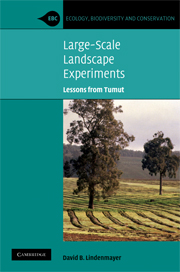Book contents
- Frontmatter
- Contents
- Preface
- Acknowledgements
- 1 The science of understanding landscape change: setting the scene for the Tumut Fragmentation Study
- 2 The theory: an overview of landscape change and habitat fragmentation
- 3 The field laboratory: the Tumut study area and the vertebrate animals it supports
- 4 Setting up the study: the design and implementation of the main cross-sectional study at Tumut
- 5 The core findings: the effects of landscape context on animals and plants
- 6 Patch use: how animals use patches of remnant eucalypt forest surrounded by pine
- 7 Theory against data: testing ecological theories and concepts
- 8 Testing PVA models with real data: melding demographic work with population modelling
- 9 Genes in the landscape: integrating genetic and demographic analyses
- 10 Refining and extending the research programme: additional studies at Tumut (and nearby) that build on the Fragmentation Study
- 11 Recommendations for plantation managers: implications for biodiversity and conservation in plantations
- 12 Lessons on running large-scale research studies: some insights from running the Tumut Fragmentation Study and directions for the future
- Appendix 1 List of collaborators/contributors to the Tumut Fragmentation Experiment
- Appendix 2 Detections of bird species in the Tumut Fragmentation Study classified by four broad classes of sites
- References
- Index
1 - The science of understanding landscape change: setting the scene for the Tumut Fragmentation Study
Published online by Cambridge University Press: 20 May 2010
- Frontmatter
- Contents
- Preface
- Acknowledgements
- 1 The science of understanding landscape change: setting the scene for the Tumut Fragmentation Study
- 2 The theory: an overview of landscape change and habitat fragmentation
- 3 The field laboratory: the Tumut study area and the vertebrate animals it supports
- 4 Setting up the study: the design and implementation of the main cross-sectional study at Tumut
- 5 The core findings: the effects of landscape context on animals and plants
- 6 Patch use: how animals use patches of remnant eucalypt forest surrounded by pine
- 7 Theory against data: testing ecological theories and concepts
- 8 Testing PVA models with real data: melding demographic work with population modelling
- 9 Genes in the landscape: integrating genetic and demographic analyses
- 10 Refining and extending the research programme: additional studies at Tumut (and nearby) that build on the Fragmentation Study
- 11 Recommendations for plantation managers: implications for biodiversity and conservation in plantations
- 12 Lessons on running large-scale research studies: some insights from running the Tumut Fragmentation Study and directions for the future
- Appendix 1 List of collaborators/contributors to the Tumut Fragmentation Experiment
- Appendix 2 Detections of bird species in the Tumut Fragmentation Study classified by four broad classes of sites
- References
- Index
Summary
The body of work that comprises the Tumut Fragmentation Study is perhaps different from other projects around the world in that a wide range of questions have been posed and many kinds of work have been undertaken in the same place. The aim of this short book is to draw together some of the key insights from this work and outline some of the lessons learned. The hope is that a synthesis from publications scattered around in different journals and books might be more than the ‘sum of its parts’. At its heart, the Tumut Fragmentation Study is all about understanding landscape change and biodiversity.
Landscape change and habitat fragmentation are processes that pose a major threat to many species. Because of this, an enormous number of studies worldwide have investigated how flora and fauna respond to them. Many of these studies have attempted to determine ways in which conservation can be more effective in areas extensively modified by humans. Themes associated with landscape change and habitat fragmentation have therefore become a major focus of conservation biology and landscape ecology (McGarigal and Cushman, 2002; Fahrig, 2003; Hobbs and Yates, 2003) and are now two of the most frequently studied processes threatening species persistence (Fazey et al., 2005; Lindenmayer and Fischer, 2006).
A huge range of studies and an enormous variety of topics fall under the broad umbrella of landscape change and habitat fragmentation. Research can be focused on single-species responses, communities or aggregate species richness. Single-species investigations often highlight the fact that each individual species responds uniquely to landscape change.
- Type
- Chapter
- Information
- Large-Scale Landscape ExperimentsLessons from Tumut, pp. 1 - 8Publisher: Cambridge University PressPrint publication year: 2009



